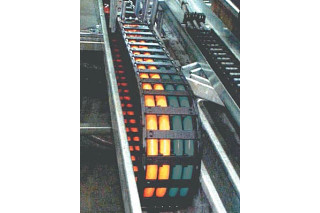Change Language :
Example 1: tested, tested, tested! Servo cable assembly

The benefits of the more complex inner sheath in shielded servo cables compared to the more cost-effective fleece taping with fillers are to be investigated. in flexible shielded cables, the shield is usually separated from the core assembly. On the one hand to achieve a rounder stranding pattern and on the other hand to prevent friction between the core insulation jacket and the braided shield by separating the core and shield. This can be achieved with an inner jacket or fleece taping, which is applied around the core. The inner jacket is more complex and therefore more expensive to produce. After stranding, the core assembly must pass through the extruder in which the inner jacket is applied. In contrast, the non-woven tape can be applied during the stranding process between the stranding point and the winding device and therefore does not require a separate process.
Comparison between the igus® solution with gusset-filling inner jacket and fleece version with fillers

The servo cables are highly flexible motor connection cables with an overall copper shield and an integrated, shielded pair of control wires. This type of cable was chosen because the problem of an out-of-round stranding pattern due to the different wire cross-sections is great here and therefore the different bending behaviour of the differently manufactured cables is emphasised.
Sample A: CF27.100.10.02.01.D(4x10 mm2 + (2x1.0 mm2) from igus® GmbH
Sample B: Test production (4x10 mm2 + (2x1.0 mm2)
Both cables have the same nominal cross-sections and insulation materials. Cable A is provided with an inner jacket and cable B with a fleece banding and fillers. The test production (sample B) already shows the formation of a corkscrew after 145,000 double strokes. The so-called corkscrew on a cable is a helical deformation, as can be seen on sample B in the following picture.
While the inner jacket of cable A fills the gusset spaces, creating a round stranded structure, cable B requires fillers in the gusset spaces. Like the core, the fillers are made of filbrised polyethylene. They are easy to compress and as a result can hardly provide any support. While the inner jacket made of TPE and the core made of cordage of cable A hold the core in a defined position, the core of cable B can move in an uncontrolled manner. During the bending process, a core of cable B has come loose from the stranding and has been displaced in the inner bend radius to the core and at the outer bend radius to the jacket, resulting in corkscrew-like deformations which are repeated periodically with the pitch length.
Evaluation
Despite the extremely low bending factor of 4.76, no signs of wear can be recognised on sample A (CF27.100.10.02.01.D) even after 5 million double strokes, while sample B with fillers and fleece taping already suffers a corkscrew after 145,000 double strokes. The result therefore justifies the additional expense of the cable with a gusset-filled inner jacket.

Sample A: CF27.100.10.02.01.D

Sample B: Trial production
More information about chainflex® cable
Consulting
I look forward to answering your questions

Katharina Wielpütz+49 2203 9649 7082Write e-mail
Shipping and consultation
In person:
Monday to Friday from 7 am - 8 pm.
Saturdays from 8 am- 12 pm.
Online:
24h
WhatsApp-Service:
Montag – Freitag: 8 – 16 Uhr

